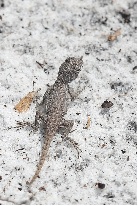Florida Scrub Lizard (Sceloporus woodi)
Description: The adult Florida scrub lizard is about 5 inches in total length (including tail). It is gray or brownish with a longitudinal brown stripe down each side of the body. The male has turquoise patches on the throat and belly. The female usually lacks the throat patches but may have lighter patches on the abdomen.
Habitat: The preferred natural habitat of S. woodi is Florida scrub, including evergreen oak and sand pine scrub. It is found less often in the ecotone between scrub and sandhill habitat, flatwoods, and citrus groves. It is most common in dry habitat with open areas for basking and nesting with nearby pines or oaks for shelter. A closed canopy makes the habitat unsuitable.
Range: S. woodi has a disjunct distribution with four main population areas, the Atlantic coast scrubs, the Gulf Coast scrubs, the inland central peninsula, and Ocala National Forest and environs. It occurs on the Lake Wales Ridge. It is common in the Ocala National Forest, but it is slowly declining in most of its range due to loss of habitat. It was more widespread before the intensive development of Florida's scrub zones and sandy ridges. Habitat loss to development, including the establishment of citrus groves, has reduced populations. Fire suppression causes habitat changes such as closure of the canopy, which eliminates the open spaces required by the species. This species occurs in widely spaced patches of a habitat type that is naturally fragmented, and it does not disperse far from its natal area. The main population groups have remained separate for many thousands of years, causing isolation that has led to the development of high genetic diversity in the species as a whole. During conservation efforts, it is important to maintain such diversity.
Found in these States:
FL
Diet: The Florida Scrub Lizard is a "sit and wait" predator that eats ants, beetles, spiders, and other small arthropods.
Reproduction: Courtship and mating of S. woodi occur in spring. The female buries up to 5 clutches of 2 to 8 eggs each. Eggs take about 75 days to hatch, probably depending on ambient temperature. The last hatchlings of the year emerge in November. The lizard becomes sexually mature in 10 to 11 months.
Status: Listed as Near Threatened because its extent of occurrence is probably not much greater than 20,000 kmē and its area of occupancy is probably not much greater than 2,000 kmē, its distribution is severely fragmented, and the extent and quality of its habitat are probably declining, thus making the species close to qualifying for Vulnerable under criteria B1ab(iii) +2ab(iii).
»» Kingdom: Animalia - Animals
»» Phylum: Chordata - Chordates
»» Subphylum: Vertebrata - Vertebrates
»» Class: Reptilia - Reptiles
»» Order: Squamata - Lizards
»» Family: Phrynosomatidae - North American Spiny Lizards
»» Genus: Sceloporus
»» Species: Sceloporus woodi - Florida Scrub Lizard
»» Subspecies: None
This article uses material from the Wikipedia article "Florida Scrub Lizard", which is released under the Creative Commons Attribution-Share-Alike License 3.0. Content may have been omitted from the original, but no content has been changed or extended.
|








